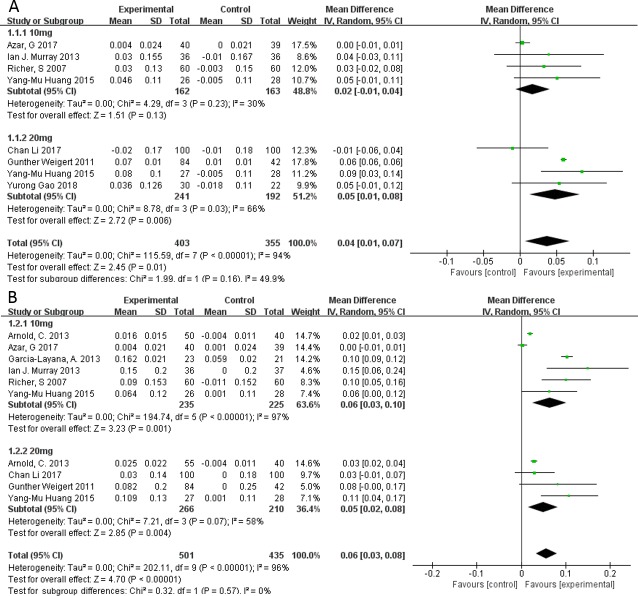Abstract
The purpose of this meta-analysis was to evaluate the effects of lutein supplementation on macular pigment optical density (MPOD) in randomized controlled trials involving patients with age-related macular degeneration (AMD). A comprehensive search of the literature was performed in PubMed, Cochrane Library, Web of Science, China National Knowledge Infrastructure, Chinese Biomedical Literature Database, and Wan Fang database through December 2018. Nine randomized controlled trials involving 920 eyes (855 with AMD) were included. Meta-analysis suggested that lutein supplementation (10 or 20 mg per day) was associated with an increase in MPOD (mean difference (MD) 0.07; 95% confidence interval (CI) 0.03 to 0.10), visual acuity (MD 0.28; 95%CI 0.06 to 0.50) and contrast sensitivity (MD 0.26; 95%CI 0.22 to 0.30). Stratified analyses showed the increase in MPOD to be faster and greater with higher dose and longer treatment. The available evidence suggests that dietary lutein may be beneficial to AMD patients and the higher dose could make MPOD increase in a shorter time.
Introduction
The macula in humans is a yellow pigmented area at the posterior of the eye that allows central vision and provides the most acute visual acuity and best color identification [1]. Macular yellow pigment was first described in 1945 as a carotenoid member of the leaf xanthophyll family [2], and more recently it was found to be primarily lutein and its structural isomer zeaxanthin [3]. Lutein is the most abundant carotenoid in the eye and brain [4]; its concentration is higher in the retina than in other tissues, and about 1,000 times higher in the retina than in serum [5]. Lutein is most dense at the macula, and its concentration declines rapidly in the peripheral regions. The concentration of lutein is approximately 2.5 times higher in the macula than in the peripheral retina. Macular pigments (MPs) concentrate in the photoreceptor axons of Henle nerve fiber layer and the rod outer segments [6], where they easily undergo oxidative attack. These carotenoids have been shown to play a key role in maintaining macular morphology and function [7, 8]. Lutein in the macula filters blue light, quenches free radicals and supports vision. As a result, lutein may play a role in prevention of age-related eye diseases, such as age-related macular degeneration and age-related cataract [9].
The levels of macular pigments, usually measured in terms of the macular pigment optical density (MPOD), can reflect retinal health status [7, 10–13]. Studies have shown significant correlations between high lutein concentration in ocular tissues or in serum and reduced risk of age-related macular degeneration (AMD) [14–16]. AMD is a leading cause of blindness in adults over 65 years old [17]. While its etiology is unclear, the disease seems to be related to excessive exposure to reactive oxygen species [18]. At present, no effective therapy exists for non-exudative AMD [1].
Since lutein must be obtained from the diet, principally from leafy green vegetables, fruits, and egg yolk [19], researchers have explored whether dietary supplementation with lutein might prevent AMD in healthy people or improve the condition of patients with AMD. Several studies support these possibilities [15, 20, 21] and have demonstrated that lutein supplementation can improve visual acuity [22]. On the other hand, one study showed that supplementation did not significantly improve MPOD in patients with early AMD [23]. One study showed no significant MPOD differences between healthy eyes and eyes with early AMD[13], although the results suggested that low MPOD is indeed related to visual function. Still other studies have concluded that melanin, rather than macular pigments, may protect against AMD [24, 25].
To help clarify these inconsistencies in the literature, we meta-analyzed available research on lutein supplementation in patients with AMD. We focused only on randomized controlled trials that measured MPOD in AMD patients who received dietary lutein or not.
Methods
This meta-analysis was conducted in accordance with the Preferred Reporting Items for Systematic Reviews and Meta-analysis (PRISMA) guidelines [26]. And the review was registered on PROSPERO at the Centre for Reviews and Dissemination (CRD42019129281).
Search strategy
A comprehensive search was performed in the following six electronic databases without data or language restriction through December 2018: PubMed, Cochrane Library, Web of Science, China National Knowledge Infrastructure, Chinese Biomedical Literature Database, and Wan Fang database. The detailed searching strategy for PubMed was as follows: (randomized controlled trial[Title/Abstract] OR randomized[Title/Abstract] OR placebo[Title/Abstract]) AND (AMD[Title/Abstract] OR age-related macular degeneration[Title/Abstract]) and (Carotenoids[Title/Abstract] OR Abscisic Acid[Title/Abstract] OR Retinoids[Title/Abstract] OR beta Carotene[Title/Abstract] OR zeta Carotene[Title/Abstract] OR Lutein[Title/Abstract] OR Canthaxanthin OR Norisoprenoids[Title/Abstract]). Additional studies were retrieved by hand from references in screened papers and systematic reviews identified during the searches.
Study selection
To be included in this meta-analysis, studies had to involve (a) a randomized controlled design in which subjects were randomly assigned to treatment (supplementation) or placebo groups, (b) subjects who were diagnosed with AMD, (c) supplementation with lutein alone or lutein with other antioxidants, and (d) MPOD as an outcome. Literature searches were screened independently by two investigators after removing duplicates. Studies were screened first based on titles and abstracts, and the remaining studies were read in full and included if they fulfilled the inclusion criteria. Disagreements were resolved by discussion between the two investigators.
Data extraction
The following data were extracted independently by two reviewers: first author, year of publication, country, sample size, age, gender, intervention, follow-up times and outcome measures. Primary outcomes, including MPOD, visual acuity, and concentration of lutein, were extracted for different time points and lutein doses. To eliminate the influence of different equipment used to measure MPOD across studies, we calculated the change in MPOD by subtracting the values before supplementation from the values after supplementation. Disagreements were resolved by consensus or opinion from a third reviewer.
Study quality assessment
Risk of bias in each study was evaluated by two reviewers using the Cochrane Collaboration tool [27] which consists of the following six items: (a) random sequence generation; (b) allocation concealment; (c) blinding of participants and personnel; (d) blinding of outcome assessment; (e) incomplete outcome data; and (f) selective reporting. Disagreements were resolved by discussion between two reviewers.
Statistical analysis
Data were pooled by Review Manager 5.3 software (Cochrane Collaboration 2014, Copenhagen, Denmark) and analyzed with random- or fixed-effects models. Data extracted were continuous and were therefore summarized as mean differences (MDs) with 95% confidence intervals (CIs) and compared between groups. Subgroup analyses were also performed to compare the effects of different doses and treatment durations. Statistical heterogeneity among studies was assessed using Q tests; the degree of heterogeneity, using the I2 value. Sensitivity analysis was conducted by excluding one study at a time and assessing whether the pooled results from the remaining studies differed from the results obtained across all studies. Publication bias was assessed using the Egger’s test in Stata software, version 13.1 (Stata Corp, College Station, TX, USA) and using a funnel plot generated by Review Manager 5.3 software. Admittedly, the funnel plot and Egger’s test is less reliable for the small number of studies in this meta-analysis [28].
Results
Studies included
We obtained 288 relevant articles from our searches of six electronic databases through December 2018. After removing duplicates, case reports, reviews and meeting abstracts, the remaining 65 articles were read in full. After excluding 56 for failing to satisfy the inclusion criteria, nine studies were ultimately included in the meta-analysis (Fig 1).
Fig 1. Flow diagram showing study inclusion and exclusion.
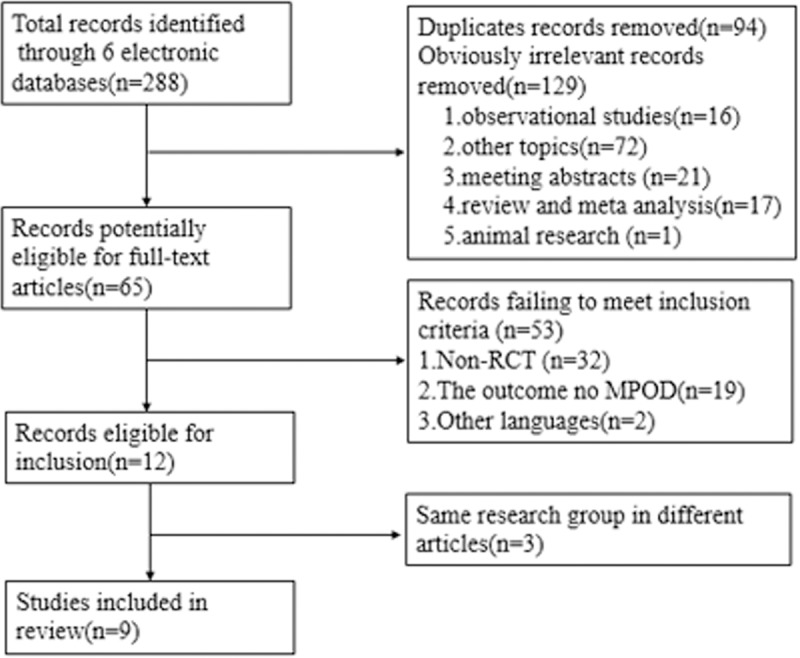
Characteristics of included studies
Altogether, the nine prospective, randomized, controlled trials involved 855 patients (920 eyes) histologically diagnosed with AMD (Table 1). Patients in the treatment group received dietary lutein supplementation and supplementation in five studies also included other antioxidants. Patients in the control group received placebo. Four studies were conducted in Asia (3 in China, 1 in Lebanon), 3 in Europe, 1 in the US, and 1 in Australia. Follow-up periods were from 3 months to 2 years. All studies included MPOD as outcome; six also measured visual acuity, three reported lutein serum concentration, and two analyzed contrast sensitivity. Risk of bias was low in all studies, which were scored as high-quality (Fig 2). In sensitivity analysis, excluding any one of studies from the analysis did not change the overall results. Publication bias was not significant, based on Egger’s test (p = 0.081), and the funnel plot was symmetric (Fig 3).
Table 1. Characteristics of included randomized controlled trials.
| Study | Participants | Participants’ characteristics |
Interventions | Measurement Method for MPOD |
Trial Duration |
|---|---|---|---|---|---|
| Yurong Gao et al. (2018)[29] | 48 AMD patients; 52 eyes |
24 dry AMD patients;24 wet AMD patients F 20; M 28 age 61.9±11.24 |
1.20mg/d lutein 2.blank |
Fundus autofluorescence |
3 months |
| Chan Li et al.(2017)[30] | 200 early AMD patients | F101; M 99 age 70.22±7.13 |
1.20mg/d lutein 2.placebo |
not given | 12 months |
| Richer, S. P. et al.(2011)[31, 32] | 60 mild-to-moderate AMD patients | F 3; M 57 age 74.9±10 |
1.8mg/d Z 2.8mg/d Z plus 9mg/d L 3.placebo |
HFP | 12 months |
| Weigert, G. et al.(2011)[33] | 126 AMD patients (stages 2,3,and 4) | age 71.6±8.6 F66; M50 |
1.20mg/d/ L 2.placebo |
Spectral fundus reflectance | 6 months |
| Arnold, C. et al(2013)[34] | 145 dry AMD patients | age 69.1±9.7 F79;M 66 BMI 27.8±4.34 |
1.10 mg L, 1 mg Z, 100 mg DHA, 30 mg EPA 2. 20 mg L, 2mg Z, 200 mg DHA, 60 mg EPA 3.placebo |
1-wavelength reflection method | 12 months |
| Garcia-Layana, A. et al.(2013)[35] | 44 early AMD patients | F18; M26 age 68.53±8.43 BMI 25±1.45 |
1.12mgL 0.6mg Z 280mgDHA 2.placebo |
HFP | 12 months |
| Murray, I. J. et al(2013)[36] | 72 AMD patients | age 70.5±8.7 F35; M37 |
1.10mg L 2.placebo |
HFP | 12 months |
| Huang, Y. M. et al.(2015)[37–39] | 81 early AMD patients | F 47; M34 age 69.33±7.32 BMI24.67±3.22 |
1.10mgL 2.20mgL 3.placebo |
Fundus autofluorescence |
24 months |
| Azar, G. et al.(2017)[40] | 126 AMD patients | F74; M52 age 75.3±7.61 BMI 25.69±4.68 |
1.5mgL1mgZ 2.placebo |
Fundus autofluorescence |
12months |
Abbreviations: HFP, heterochromic flicker photometry; F, female; M, male; BMI, body mass index; Z: zeaxanthin; L: lutein.
Fig 2. Risk of various biases and summary of the risk of bias, as determined by the Cochrane Collaboration tool.
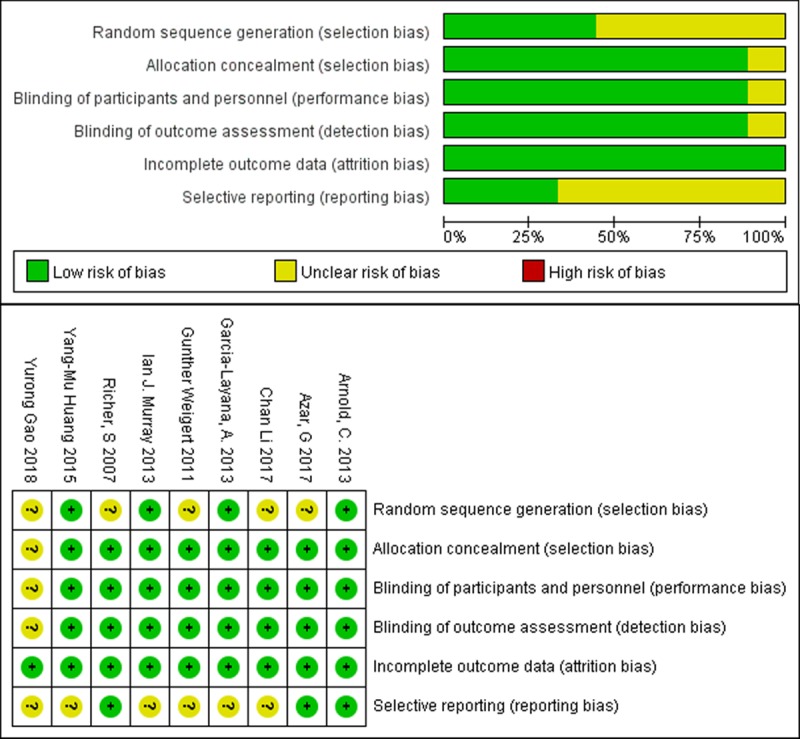
Fig 3. Egger’s test and funnel plot for MPOD across all studies.
Effects of lutein supplementation in AMD patients
MPOD
Random-effects meta-analysis of all nine studies showed that lutein supplementation was associated with higher MPOD (MD 0.07; 95%CI 0.03 to 0.10). Stratified analyses based on length of supplementation showed that MPOD was significantly higher with 10 mg/d lutein than with placebo after more than 1 year (MD 0.06; 95%CI 0.03 to 0.10); but not after fewer than 6 months (MD 0.02; 95%CI -0.01 to 0.04). At the higher dose of 20 mg/d lutein, MPOD was significantly higher in the treatment group than the placebo group after fewer than 6 months (MD 0.05; 95%CI 0.01 to 0.08) as well as after more than 1 year (MD 0.05; 95%CI 0.02 to 0.08) (Fig 4).
Fig 4.
Forest plot showing the effect of lutein supplementation on macular pigment optical density in AMD patients when supplementation lasted (A) fewer than 6 months or (B) longer than 1 year.
Visual acuity
Random-effects meta-analysis of the six studies that included visual acuity as an outcome showed that lutein supplementation for longer than 1 year led to significantly greater visual acuity than placebo (MD 0.28; 95%CI 0.06 to 0.50, Fig 5).
Fig 5. Forest plot showing the effect of lutein supplementation on visual acuity in AMD patients.
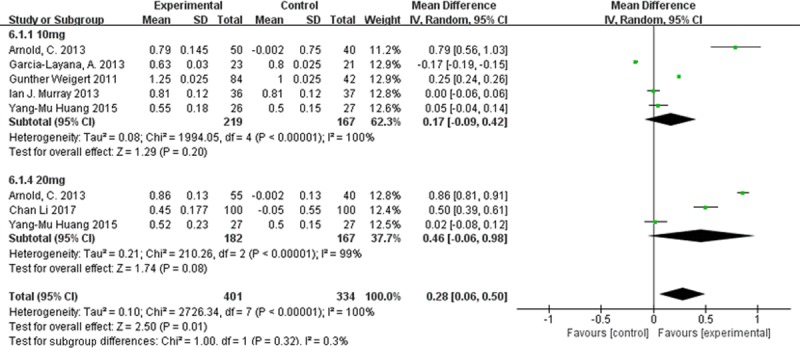
Serum lutein concentration
Random-effects meta-analysis of the three studies that reported lutein concentrations in serum showed that lutein concentration was significantly higher in the treatment group than in the placebo group (MD 1.10; 95%CI 0.54 to 1.67, Fig 6).
Fig 6. Forest plot showing the effect of lutein supplementation on serum lutein concentration in AMD patients.
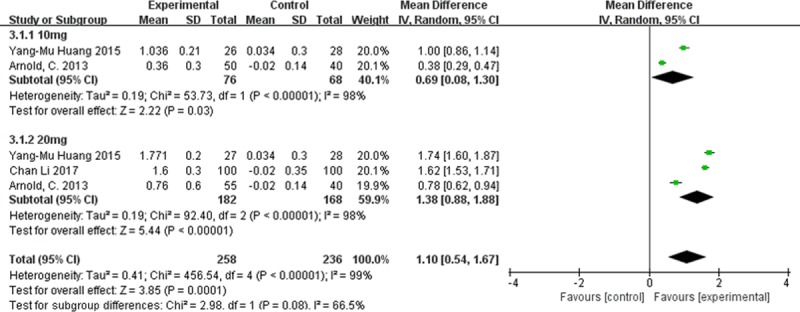
Contrast sensitivity
Fixed-effects meta-analysis of the two studies that reported contrast sensitivity showed that lutein supplementation was associated with higher contrast sensitivity at spatial frequencies of 3, 6, 12 and 18 cycles per degree (MD 0.26; 95%CI 0.22 to 0.30, Fig 7).
Fig 7. Forest plot showing the effect of lutein supplementation on contrast sensitivity in AMD patients.
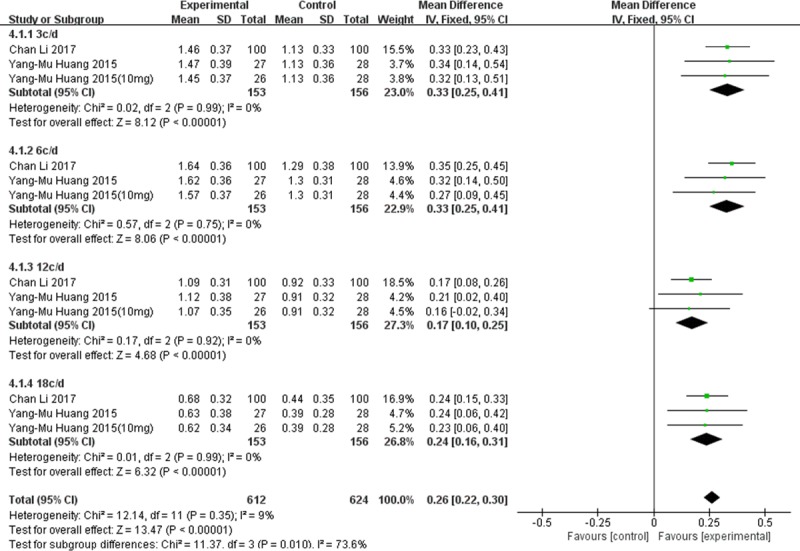
Discussion
Macular pigments, including the carotenoids lutein, play important roles in maintaining macular function and overall retinal function [4]. Lutein protects the retina by filtering out blue light and acting as an antioxidant [2, 41], and administering it to animals can significantly increase anti-oxidant enzyme levels and total anti-oxidant capacity [42]. Lutein and other carotenoids also suppress production of inflammatory mediators and reactive oxygen species, and they down-regulate NADPH oxidase subunit Nox4 [43, 44]. In cell culture studies, lutein protected ARPE-19 retinal cells from oxidative stress-induced cellular senescence [45], likely by quenching singlet oxygen [46]. These anti-oxidative properties have led to the suggestion that lutein may slow AMD progression and alleviate symptoms [47]. Our meta-analysis of randomized controlled trials suggests that this may indeed be the case. However, studies performed supplementation for a maximum of 5 years, leaving open the question of whether lutein supplementation can effectively treat AMD, a chronic progressive disease, in longer term. But due to the limitations of existing RCT trials, we can only evaluate the effect of lutein on AMD within 1 year.
Culture, animal and human studies have shown that retinal concentrations of lutein are inversely related to the risk of AMD [42, 45, 48]. The same study also provided evidence that low concentration of lutein may actually cause AMD [48]. Another study showed that low macular pigment level was related to worse vision in both healthy subjects and AMD patients [13]. Consistent with these findings, lutein supplementation improved vision in healthy subjects and reduced their risk of developing AMD [8, 49]. In addition, many clinical studies have shown that a diet that increases macular pigment levels can improve retinal function, especially in AMD patients with low MPOD [13, 50, 51].
In this way, our results that lutein supplementation can increase MPOD and visual acuity are in agreement with previous studies and a meta-analysis that included fewer studies than ours [52]. On the other hand, one meta-analysis suggested little to no benefit of lutein against AMD progression [53]. The results of that analysis may be less reliable because among the 19 studies included, only 6 examined lutein in AMD, and most data came from a single study (AREDS2). In addition, the meta-analysis did not stratify data by duration of supplementation, which ranged from six months to five years. As we know, AMD is a chronic progressive disease, intervention and follow-up time may affect the outcome effects.
The lack of efficacy for lutein supplementation in AMD patients may reflect the treatment that was too short and/or doses that were too low [23]. Our stratified analyses suggest the importance of providing lutein at sufficiently high doses and durations: daily doses of at least 20mg showed efficacy within 6 months, compared to 1 year for daily doses of 10mg. However, at least one study showed that 10 mg lutein had the same effect as 20 mg per day [52], which contradicts our results. This raises the possibility that the efficacy of lutein supplementation depends on multiple factors. In any event, lutein or zeaxanthin appears to be safe in rats at up to 400mg/kg per day [54], and lutein appears to be safe in humans at up to 20mg per day [55].
Another reason that clinical lutein studies have come to divergent results may be differences in the study populations. MPOD and the ability of response to carotenoid supplementation may differ with genetic variations [56, 57]. Unfortunately we could not assess the potential contribution of genetic polymorphism to our results because none of the studies in our meta-analysis included genotyping data. Some studies did record BMI, because BMI would affect the concentration of lutein in serum [58], which was found not to differ significantly between patients who received supplementation or not. One study suggested that iris color affects MPOD, but another showed no such relationship [59]. Iris color was not recorded in studies included in this meta-analysis and therefore could not be analyzed.
Another source of variability among studies in the literature is the different ways to determine MPOD. There are many different methods to measure MPOD, including fundus reflectance, auto-reflectance and psychophysical methods [60, 61]. Most studies in our meta-analysis used a heterochromatic flicker photometer, which is commonly used but not always reproducible in clinical [62]. Some of the included studies did not report how MOPD was measured. To minimize the impact of different MPOD measurement methods, our meta-analysis was based on the change in MPOD from before supplementation, rather than absolute MPOD after supplementation.
One weakness of our meta-analysis is that heterogeneity was relatively high. This may reflect differences in the type of supplementation: five of the studies involved supplementation with lutein in combination with other antioxidants, such as zeaxanthin, meso-zeaxanthin, and zinc. Such mixtures may be more effective at quenching singlet oxygen than individual carotenoids at the same concentration [63, 64]. Another source of heterogeneity is the type and stage of AMD: most patients in this meta-analysis had dry-type AMD, but one study included patients with wet-type disease. AMD stage varied across studies. Our finding should be verified and extended in studies that control for these factors.
Conclusions
The available evidence suggests that dietary intake of lutein (10 or 20 mg/day) for more than 6 months can significantly improve MPOD and visual acuity in AMD patients.
Supporting information
(DOC)
(DOC)
Acknowledgments
We thank Shangfei Yang for providing valuable guidance on data extraction and software selection.
Data Availability
All relevant data are within the paper and its Supporting Information files.
Funding Statement
This study was supported by National Natural Science Foundation of China (No. 81670869). The funders had no role in study design, data collection and analysis, decision to publish, or preparation of the manuscript.
References
- 1.van Lookeren Campagne M, LeCouter J, Yaspan BL, Ye W. Mechanisms of age-related macular degeneration and therapeutic opportunities. The Journal of pathology. 2014;232(2):151–64. Epub 2013/10/10. 10.1002/path.4266 . [DOI] [PubMed] [Google Scholar]
- 2.Wald G. HUMAN VISION AND THE SPECTRUM. Science (New York, NY). 1945;101(2635):653–8. Epub 1945/06/29. 10.1126/science.101.2635.653 . [DOI] [PubMed] [Google Scholar]
- 3.Bone RA, Landrum JT, Tarsis SL. Preliminary identification of the human macular pigment. Vision research. 1985;25(11):1531–5. Epub 1985/01/01. 10.1016/0042-6989(85)90123-3 . [DOI] [PubMed] [Google Scholar]
- 4.Johnson EJ. Role of lutein and zeaxanthin in visual and cognitive function throughout the lifespan. Nutrition reviews. 2014;72(9):605–12. Epub 2014/08/12. 10.1111/nure.12133 . [DOI] [PubMed] [Google Scholar]
- 5.Bone RA, Landrum JT, Dixon Z, Chen Y, Llerena CM. Lutein and zeaxanthin in the eyes, serum and diet of human subjects. Experimental eye research. 2000;71(3):239–45. Epub 2000/09/07. 10.1006/exer.2000.0870 . [DOI] [PubMed] [Google Scholar]
- 6.Snodderly DM, Auran JD, Delori FC. The macular pigment. II. Spatial distribution in primate retinas. Investigative ophthalmology & visual science. 1984;25(6):674–85. Epub 1984/06/01. . [PubMed] [Google Scholar]
- 7.Bernstein PS, Li B, Vachali PP, Gorusupudi A, Shyam R, Henriksen BS, et al. Lutein, zeaxanthin, and meso-zeaxanthin: The basic and clinical science underlying carotenoid-based nutritional interventions against ocular disease. Progress in retinal and eye research. 2016;50:34–66. Epub 2015/11/07. 10.1016/j.preteyeres.2015.10.003 [DOI] [PMC free article] [PubMed] [Google Scholar]
- 8.Eggersdorfer M, Wyss A. Carotenoids in human nutrition and health. Archives of biochemistry and biophysics. 2018;652:18–26. Epub 2018/06/10. 10.1016/j.abb.2018.06.001 . [DOI] [PubMed] [Google Scholar]
- 9.Kijlstra A, Tian Y, Kelly ER, Berendschot TT. Lutein: more than just a filter for blue light. Progress in retinal and eye research. 2012;31(4):303–15. Epub 2012/04/03. 10.1016/j.preteyeres.2012.03.002 . [DOI] [PubMed] [Google Scholar]
- 10.Ozawa Y, Shigeno Y, Nagai N, Suzuki M, Kurihara T, Minami S, et al. Absolute and estimated values of macular pigment optical density in young and aged Asian participants with or without age-related macular degeneration. BMC Ophthalmol. 2017;17(1):161 Epub 2017/08/31. 10.1186/s12886-017-0557-5 [DOI] [PMC free article] [PubMed] [Google Scholar]
- 11.Loane E, Kelliher C, Beatty S, Nolan JM. The rationale and evidence base for a protective role of macular pigment in age-related maculopathy. British Journal of Ophthalmology. 2008;92(9):1163–8. 10.1136/bjo.2007.135566 [DOI] [PubMed] [Google Scholar]
- 12.Sabour-Pickett S, Nolan JM, Loughman J, Beatty S. A review of the evidence germane to the putative protective role of the macular carotenoids for age-related macular degeneration. Molecular nutrition & food research. 2012;56(2):270–86. Epub 2011/11/29. 10.1002/mnfr.201100219 . [DOI] [PubMed] [Google Scholar]
- 13.Puell MC, Palomo-Alvarez C, Barrio AR, Gomez-Sanz FJ, Perez-Carrasco MJ. Relationship between macular pigment and visual acuity in eyes with early age-related macular degeneration. Acta ophthalmologica. 2013;91(4):e298–303. Epub 2013/04/12. 10.1111/aos.12067 . [DOI] [PubMed] [Google Scholar]
- 14.Korobelnik JF, Rougier MB, Delyfer MN, Bron A, Merle BMJ, Savel H, et al. Effect of Dietary Supplementation With Lutein, Zeaxanthin, and omega-3 on Macular Pigment: A Randomized Clinical Trial. JAMA ophthalmology. 2017;135(11):1259–66. Epub 2017/10/04. 10.1001/jamaophthalmol.2017.3398 [DOI] [PMC free article] [PubMed] [Google Scholar]
- 15.Arslan S, Kadayifcilar S, Samur G. The Potential Role of Dietary Antioxidant Capacity in Preventing Age-Related Macular Degeneration. Journal of the American College of Nutrition. 2018:1–9. Epub 2018/12/21. 10.1080/07315724.2018.1538830 . [DOI] [PubMed] [Google Scholar]
- 16.Rinninella E, Mele MC, Merendino N, Cintoni M, Anselmi G, Caporossi A, et al. The Role of Diet, Micronutrients and the Gut Microbiota in Age-Related Macular Degeneration: New Perspectives from the Gut(-)Retina Axis. Nutrients. 2018;10(11). Epub 2018/11/08. 10.3390/nu10111677 [DOI] [PMC free article] [PubMed] [Google Scholar]
- 17.Wong WL, Su X, Li X, Cheung CM, Klein R, Cheng CY, et al. Global prevalence of age-related macular degeneration and disease burden projection for 2020 and 2040: a systematic review and meta-analysis. The Lancet Global health. 2014;2(2):e106–16. Epub 2014/08/12. 10.1016/S2214-109X(13)70145-1 . [DOI] [PubMed] [Google Scholar]
- 18.Hyttinen JMT, Viiri J, Kaarniranta K, Blasiak J. Mitochondrial quality control in AMD: does mitophagy play a pivotal role? Cellular and molecular life sciences: CMLS. 2018;75(16):2991–3008. Epub 2018/05/20. 10.1007/s00018-018-2843-7 . [DOI] [PMC free article] [PubMed] [Google Scholar]
- 19.Chung RWS, Leanderson P, Gustafsson N, Jonasson L. Liberation of lutein from spinach: Effects of heating time, microwave-reheating and liquefaction. Food chemistry. 2019;277:573–8. Epub 2018/12/07. 10.1016/j.foodchem.2018.11.023 . [DOI] [PubMed] [Google Scholar]
- 20.Chew EY, Clemons TE, Agron E, Launer LJ, Grodstein F, Bernstein PS. Effect of Omega-3 Fatty Acids, Lutein/Zeaxanthin, or Other Nutrient Supplementation on Cognitive Function: The AREDS2 Randomized Clinical Trial. Jama. 2015;314(8):791–801. Epub 2015/08/26. 10.1001/jama.2015.9677 [DOI] [PMC free article] [PubMed] [Google Scholar]
- 21.Tan JS, Wang JJ, Flood V, Rochtchina E, Smith W, Mitchell P. Dietary antioxidants and the long-term incidence of age-related macular degeneration: the Blue Mountains Eye Study. Ophthalmology. 2008;115(2):334–41. Epub 2007/08/01. 10.1016/j.ophtha.2007.03.083 . [DOI] [PubMed] [Google Scholar]
- 22.Fujimura S, Ueda K, Nomura Y, Yanagi Y. Preliminary analysis of the relationship between serum lutein and zeaxanthin levels and macular pigment optical density. Clinical ophthalmology (Auckland, NZ). 2016;10:2149–55. Epub 2016/11/09. 10.2147/opth.s119251 [DOI] [PMC free article] [PubMed] [Google Scholar]
- 23.Sasamoto Y, Gomi F, Sawa M, Tsujikawa M, Nishida K. Effect of 1-year lutein supplementation on macular pigment optical density and visual function. Graefe's archive for clinical and experimental ophthalmology = Albrecht von Graefes Archiv fur klinische und experimentelle Ophthalmologie. 2011;249(12):1847–54. Epub 2011/08/19. 10.1007/s00417-011-1780-z . [DOI] [PubMed] [Google Scholar]
- 24.Kanis MJ, Wisse RP, Berendschot TT, van de Kraats J, van Norren D. Foveal cone-photoreceptor integrity in aging macula disorder. Investigative ophthalmology & visual science. 2008;49(5):2077–81. Epub 2008/01/29. 10.1167/iovs.07-1181 . [DOI] [PubMed] [Google Scholar]
- 25.Dieguez HH, Romeo HE, Alaimo A, Gonzalez Fleitas MF, Aranda ML, Rosenstein RE, et al. Oxidative stress damage circumscribed to the central temporal retinal pigment epithelium in early experimental non-exudative age-related macular degeneration. Free radical biology & medicine. 2019;131:72–80. Epub 2018/12/07. 10.1016/j.freeradbiomed.2018.11.035 . [DOI] [PubMed] [Google Scholar]
- 26.Moher D, Shamseer L, Clarke M, Ghersi D, Liberati A, Petticrew M, et al. Preferred reporting items for systematic review and meta-analysis protocols (PRISMA-P) 2015 statement. Systematic Reviews. 2015;4(1):1 10.1186/2046-4053-4-1 [DOI] [PMC free article] [PubMed] [Google Scholar]
- 27.Higgins JP, Altman DG, Gotzsche PC, Juni P, Moher D, Oxman AD, et al. The Cochrane Collaboration's tool for assessing risk of bias in randomised trials. BMJ (Clinical research ed). 2011;343:d5928 Epub 2011/10/20. 10.1136/bmj.d5928 [DOI] [PMC free article] [PubMed] [Google Scholar]
- 28.Zwetsloot PP, Van Der Naald M, Sena ES, Howells DW, IntHout J, De Groot JA, et al. Standardized mean differences cause funnel plot distortion in publication bias assessments. eLife. 2017;6 Epub 2017/09/09. 10.7554/eLife.24260 [DOI] [PMC free article] [PubMed] [Google Scholar]
- 29.Xudong GRZJSXH. Clinical observation of macular pigment optical density changes on visual functions in patients with age-related macular degeneration. BMU Journal. 2018;41(3):185–7,240. [Google Scholar]
- 30.Sui CLWRYJ. Effect of lutein intervention on visual function in patients with early age-related macular degeneration. Int Eye Sci. 2017. [Google Scholar]
- 31.Richer SP, Stiles W, Graham-Hoffman K, Levin M, Ruskin D, Wrobel J, et al. Randomized, double-blind, placebo-controlled study of zeaxanthin and visual function in patients with atrophic age-related macular degeneration: the Zeaxanthin and Visual Function Study (ZVF) FDA IND #78, 973. Optometry (St Louis, Mo). 2011;82(11):667–80.e6. Epub 2011/10/27. 10.1016/j.optm.2011.08.008 . [DOI] [PubMed] [Google Scholar]
- 32.Richer S, Devenport J, Lang JC. LAST II: Differential temporal responses of macular pigment optical density in patients with atrophic age-related macular degeneration to dietary supplementation with xanthophylls. Optometry (St Louis, Mo). 2007;78(5):213–9. Epub 2007/05/05. 10.1016/j.optm.2006.10.019 . [DOI] [PubMed] [Google Scholar]
- 33.Weigert G, Kaya S, Pemp B, Sacu S, Lasta M, Werkmeister RM, et al. Effects of lutein supplementation on macular pigment optical density and visual acuity in patients with age-related macular degeneration. Investigative ophthalmology & visual science. 2011;52(11):8174–8. Epub 2011/08/30. 10.1167/iovs.11-7522 . [DOI] [PubMed] [Google Scholar]
- 34.Arnold C, Winter L, Frohlich K, Jentsch S, Dawczynski J, Jahreis G, et al. Macular xanthophylls and omega-3 long-chain polyunsaturated fatty acids in age-related macular degeneration: a randomized trial. JAMA ophthalmology. 2013;131(5):564–72. Epub 2013/03/23. 10.1001/jamaophthalmol.2013.2851 [DOI] [PubMed] [Google Scholar]
- 35.Garcia-Layana A, Recalde S, Alaman AS, Robredo PF. Effects of lutein and docosahexaenoic Acid supplementation on macular pigment optical density in a randomized controlled trial. Nutrients. 2013;5(2):543–51. Epub 2013/02/26. 10.3390/nu5020543 [DOI] [PMC free article] [PubMed] [Google Scholar]
- 36.Murray IJ, Makridaki M, van der Veen RL, Carden D, Parry NR, Berendschot TT. Lutein supplementation over a one-year period in early AMD might have a mild beneficial effect on visual acuity: the CLEAR study. Investigative ophthalmology & visual science. 2013;54(3):1781–8. Epub 2013/02/07. 10.1167/iovs.12-10715 . [DOI] [PubMed] [Google Scholar]
- 37.Huang YM, Dou HL, Huang FF, Xu XR, Zou ZY, Lu XR, et al. Changes following supplementation with lutein and zeaxanthin in retinal function in eyes with early age-related macular degeneration: a randomised, double-blind, placebo-controlled trial. The British journal of ophthalmology. 2015;99(3):371–5. Epub 2014/09/18. 10.1136/bjophthalmol-2014-305503 . [DOI] [PubMed] [Google Scholar]
- 38.Ma L, Yan SF, Huang YM, Lu XR, Qian F, Pang HL, et al. Effect of lutein and zeaxanthin on macular pigment and visual function in patients with early age-related macular degeneration. Ophthalmology. 2012;119(11):2290–7. Epub 2012/08/04. 10.1016/j.ophtha.2012.06.014 . [DOI] [PubMed] [Google Scholar]
- 39.Ma L, Dou HL, Huang YM, Lu XR, Xu XR, Qian F, et al. Improvement of retinal function in early age-related macular degeneration after lutein and zeaxanthin supplementation: a randomized, double-masked, placebo-controlled trial. American journal of ophthalmology. 2012;154(4):625–34.e1. Epub 2012/07/28. 10.1016/j.ajo.2012.04.014 . [DOI] [PubMed] [Google Scholar]
- 40.Azar G, Quaranta-El Maftouhi M, Masella JJ, Mauget-Faysse M. Macular pigment density variation after supplementation of lutein and zeaxanthin using the Visucam((R)) 200 pigment module: Impact of age-related macular degeneration and lens status. Journal francais d'ophtalmologie. 2017;40(4):303–13. Epub 2017/03/25. 10.1016/j.jfo.2016.11.009 . [DOI] [PubMed] [Google Scholar]
- 41.Akuffo KO, Nolan JM, Peto T, Stack J, Leung I, Corcoran L, et al. Relationship between macular pigment and visual function in subjects with early age-related macular degeneration. The British journal of ophthalmology. 2017;101(2):190–7. Epub 2016/04/20. 10.1136/bjophthalmol-2016-308418 [DOI] [PMC free article] [PubMed] [Google Scholar]
- 42.Madhavan J, Chandrasekharan S, Priya MK, Godavarthi A. Modulatory Effect of Carotenoid Supplement Constituting Lutein and Zeaxanthin (10:1) on Anti-oxidant Enzymes and Macular Pigments Level in Rats. Pharmacognosy magazine. 2018;14(54):268–74. Epub 2018/05/04. 10.4103/pm.pm_340_17 [DOI] [PMC free article] [PubMed] [Google Scholar]
- 43.Yanai R, Chen S, Uchi SH, Nanri T, Connor KM, Kimura K. Attenuation of choroidal neovascularization by dietary intake of omega-3 long-chain polyunsaturated fatty acids and lutein in mice. PloS one. 2018;13(4):e0196037 Epub 2018/04/26. 10.1371/journal.pone.0196037 [DOI] [PMC free article] [PubMed] [Google Scholar]
- 44.Tuzcu M, Orhan C, Muz OE, Sahin N, Juturu V, Sahin K. Lutein and zeaxanthin isomers modulates lipid metabolism and the inflammatory state of retina in obesity-induced high-fat diet rodent model. BMC Ophthalmol. 2017;17(1):129 Epub 2017/07/26. 10.1186/s12886-017-0524-1 [DOI] [PMC free article] [PubMed] [Google Scholar]
- 45.Chae SY, Park SY, Park G. Lutein protects human retinal pigment epithelial cells from oxidative stressinduced cellular senescence. Molecular medicine reports. 2018;18(6):5182–90. Epub 2018/10/16. 10.3892/mmr.2018.9538 . [DOI] [PubMed] [Google Scholar]
- 46.Zareba M, Widomska J, Burke JM, Subczynski WK. Nitroxide free radicals protect macular carotenoids against chemical destruction (bleaching) during lipid peroxidation. Free radical biology & medicine. 2016;101:446–54. Epub 2016/11/15. 10.1016/j.freeradbiomed.2016.11.012 [DOI] [PMC free article] [PubMed] [Google Scholar]
- 47.Mettu PS, Wielgus AR, Ong SS, Cousins SW. Retinal pigment epithelium response to oxidant injury in the pathogenesis of early age-related macular degeneration. Mol Aspects Med. 2012;33(4):376–98. Epub 2012/05/12. 10.1016/j.mam.2012.04.006 . [DOI] [PubMed] [Google Scholar]
- 48.Bone RA, Landrum JT, Mayne ST, Gomez CM, Tibor SE, Twaroska EE. Macular pigment in donor eyes with and without AMD: a case-control study. Investigative ophthalmology & visual science. 2001;42(1):235–40. Epub 2001/01/03. . [PubMed] [Google Scholar]
- 49.Gopinath B, Liew G, Tang D, Burlutsky G, Flood VM, Mitchell P. Consumption of eggs and the 15-year incidence of age-related macular degeneration. Clinical nutrition (Edinburgh, Scotland). 2019. Epub 2019/03/28. 10.1016/j.clnu.2019.03.009 . [DOI] [PubMed] [Google Scholar]
- 50.Li S, Liu N, Lin L, Sun ED, Li JD, Li PK. Macular pigment and serum zeaxanthin levels with Goji berry supplement in early age-related macular degeneration. International journal of ophthalmology. 2018;11(6):970–5. Epub 2018/07/07. 10.18240/ijo.2018.06.12 [DOI] [PMC free article] [PubMed] [Google Scholar]
- 51.Papudesu C, Clemons TE, Agron E, Chew EY. Association of Mortality with Ocular Diseases and Visual Impairment in the Age-Related Eye Disease Study 2: Age-Related Eye Disease Study 2 Report Number 13. Ophthalmology. 2018;125(4):512–21. Epub 2017/11/21. 10.1016/j.ophtha.2017.10.028 [DOI] [PMC free article] [PubMed] [Google Scholar]
- 52.Wang X, Jiang C, Zhang Y, Gong Y, Chen X, Zhang M. Role of lutein supplementation in the management of age-related macular degeneration: meta-analysis of randomized controlled trials. Ophthalmic research. 2014;52(4):198–205. Epub 2014/11/02. 10.1159/000363327 . [DOI] [PubMed] [Google Scholar]
- 53.Evans JR, Lawrenson JG. Antioxidant vitamin and mineral supplements for slowing the progression of age-related macular degeneration. The Cochrane database of systematic reviews. 2017;7:Cd000254 Epub 2017/08/02. 10.1002/14651858.CD000254.pub4 [DOI] [PMC free article] [PubMed] [Google Scholar]
- 54.Ravikrishnan R, Rusia S, Ilamurugan G, Salunkhe U, Deshpande J, Shankaranarayanan J, et al. Safety assessment of lutein and zeaxanthin (Lutemax 2020): subchronic toxicity and mutagenicity studies. Food and chemical toxicology: an international journal published for the British Industrial Biological Research Association. 2011;49(11):2841–8. Epub 2011/08/30. 10.1016/j.fct.2011.08.011 . [DOI] [PubMed] [Google Scholar]
- 55.Shao A, Hathcock JN. Risk assessment for the carotenoids lutein and lycopene. Regulatory toxicology and pharmacology: RTP. 2006;45(3):289–98. Epub 2006/07/04. 10.1016/j.yrtph.2006.05.007 . [DOI] [PubMed] [Google Scholar]
- 56.Yonova-Doing E, Hysi PG, Venturini C, Williams KM, Nag A, Beatty S, et al. Candidate gene study of macular response to supplemental lutein and zeaxanthin. Experimental eye research. 2013;115:172–7. Epub 2013/07/31. 10.1016/j.exer.2013.07.020 [DOI] [PMC free article] [PubMed] [Google Scholar]
- 57.Koo E, Neuringer M, SanGiovanni JP. Macular xanthophylls, lipoprotein-related genes, and age-related macular degeneration. The American journal of clinical nutrition. 2014;100 Suppl 1:336s–46s. Epub 2014/05/16. 10.3945/ajcn.113.071563 [DOI] [PMC free article] [PubMed] [Google Scholar]
- 58.Kirby ML, Beatty S, Stack J, Harrison M, Greene I, McBrinn S, et al. Changes in macular pigment optical density and serum concentrations of lutein and zeaxanthin in response to weight loss. The British journal of nutrition. 2011;105(7):1036–46. Epub 2010/12/15. 10.1017/S0007114510004721 . [DOI] [PubMed] [Google Scholar]
- 59.Tudosescu R, Alexandrescu CM, Istrate SL, Vrapciu AD, Ciuluvica RC, Voinea L. Correlations between internal and external ocular factors and macular pigment optical density. Romanian journal of ophthalmology. 2018;62(1):42–7. Epub 2018/05/26. [PMC free article] [PubMed] [Google Scholar]
- 60.Putnam CM. Clinical imaging of macular pigment optical density and spatial distribution. Clinical & experimental optometry. 2017;100(4):333–40. Epub 2016/11/26. 10.1111/cxo.12500 . [DOI] [PubMed] [Google Scholar]
- 61.Sharifzadeh M, Obana A, Gohto Y, Seto T, Gellermann W. Autofluorescence imaging of macular pigment: influence and correction of ocular media opacities. Journal of biomedical optics. 2014;19(9):96010 Epub 2014/09/17. 10.1117/1.JBO.19.9.096010 . [DOI] [PubMed] [Google Scholar]
- 62.Bartlett H, Howells O, Eperjesi F. The role of macular pigment assessment in clinical practice: a review. Clinical & experimental optometry. 2010;93(5):300–8. Epub 2010/07/16. 10.1111/j.1444-0938.2010.00499.x . [DOI] [PubMed] [Google Scholar]
- 63.Li B, Ahmed F, Bernstein PS. Studies on the singlet oxygen scavenging mechanism of human macular pigment. Archives of biochemistry and biophysics. 2010;504(1):56–60. Epub 2010/08/04. 10.1016/j.abb.2010.07.024 [DOI] [PMC free article] [PubMed] [Google Scholar]
- 64.Meagher KA, Thurnham DI, Beatty S, Howard AN, Connolly E, Cummins W, et al. Serum response to supplemental macular carotenoids in subjects with and without age-related macular degeneration. The British journal of nutrition. 2013;110(2):289–300. Epub 2012/12/06. 10.1017/S0007114512004837 . [DOI] [PubMed] [Google Scholar]
Associated Data
This section collects any data citations, data availability statements, or supplementary materials included in this article.
Supplementary Materials
(DOC)
(DOC)
Data Availability Statement
All relevant data are within the paper and its Supporting Information files.




